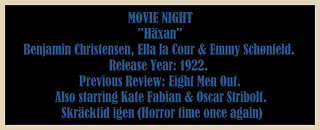
Review #1288: Häxan.
Cast:
Benjamin Christensen (the Devil), Ella la Cour (Sorceress Karna), Emmy Schønfeld (Karna's Assistant), Kate Fabian (the Old Maid), Oscar Stribolt (the Fat Monk), Wilhelmine Henriksen (Apelone), Astrid Holm (Anna), Elisabeth Christensen (Anna's Mother), Karen Winther (Anna's Sister), Maren Pedersen (the Witch), Johannes Andersen (Pater Henrik, Witch Judge), Elith Pio (Johannes, Witch Judge), Aage Hertel (Witch Judge), and Ib Schønberg (Witch Judge) Written and Directed by Benjamin Christensen.
Review:
Like goodness in heart, evil can exist anywhere. This proves true when it comes to witches and their part in culture, and how superstition can play a part in hysteria. Christensen had found a copy of Malleus Maleficarum, a late 15th century treatise on witchcraft that endorsed the extermination of witches while recommending inquisitorial practices to deal with them, such as torture. For two years, he spent his time studying manuals, illustrations and treatises on witches and the hunt, striving to make an innovative film that was not merely an adaptation of past material. Häxan (known as Heksen in Denmark) was expensive for its time, made for 1.5-2 million kronor. The film was a Sweden-Denmark co-production, where he used funding from Svensk Filmindustri to refurbish the Astra studio in Denmark; the movie spent over a year in production, where filming was done only at night or on a closed set, while post-production meant that it did not premiere until September of 1922 (in four Swedish cities at once). Its premiere in Copenhagen, Denmark two months later was accompanied by a 50-piece orchestra, complete with a bibliography in its original playbill (an American release did not follow until 1929). Although it is generally regarded as a documentary, it does invoke horror within its dramatized sequences, particularly with its imagery. It certainly is an imaginative work to look at, that much is for sure.
It is obvious to credit the craftsmanship done by Christensen with his third directorial effort (alongside writing and starring) that had begun in 1914 with The Mysterious X - he clearly made the effort to deliver a creepy panorama that seeks to deliver a lesson in the past that still stands tall for the present after nearly a century. He of course is not the only one meriting credit for the film's success, where he thanks the art director (Richard Louw) and cinematographer (Johan Ankerstjerne) for their work on the film. It sure is an unsettling movie to view, where its lecture on cultural history can blend fact and fiction so handily through the lens of a silent film, where patience can be the best virtue to enjoyment. The actors certainly seem game to roll with the weird yet captivating nature of what goes on in its 104 minute run-time, with their weary eyes resonating with its medieval settings (alongside later moments spent in the modern age, where the problem is now hysteria rather than accusations of witchcraft), with Christensen lurking quite well as the beast below without going for camp. Everyone plays it pretty straight, whether involving monks, old and young accused of witchcraft, or inquistors tasked to deal with such fears. One can still think of this film today as still being important to understanding the nature of superstition, fear, and what we hold on to when it comes to belief with fantasy and desire. We may not accuse people of being witches today, but it doesn't mean the real world is free of irrational things that bind us.
There have been a few re-releases and restorations over the years of various lengths. A 1940 Danish release had an extended introduction from Christensen with the inter-titles re-worded, a 1968 Metro Pictures release re-edited the film (now known as just Witchcraft through the Ages) to have narration from William S. Burroughs and a jazz score (lasting 74 minutes), and the Swedish Film Institute has restored the movie three times, beginning in 1976 (finding a decent quality print on the Internet is not too big of a challenge, however). To close it out, let me invoke some words that Christensen wrote for an article around the time this movie was being made: "I would like to know at this time whether a film is able to hold the public’s interest without mass effects, without sentimentality, without suspense, without heroes and heroines—in short, without all those things on which a good film is otherwise constructed. My films consist of a series of episodes that—as part of a mosaic—give expression to an idea.” I think he did just fine in that regard with a film basked in morbid realism that lines up just nicely for the horror season. It takes its time to get going, but when it does find its footing, it works up a storm of interesting imagery and a fine look and music to go along with quite a thrill to look at.
Overall, I give it 9 out of 10 stars.

No comments:
Post a Comment